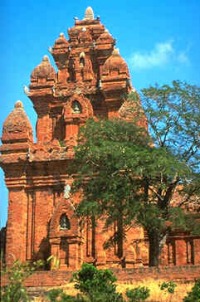| About Us | Site Map | Contact Us |
|
|
| Home | Schools & Teachings | Dharma Centers | Buddha & Bodhisattva Directory | Cosmos |
|
|
Vietnamese Buddhism
|
Buddhist entered Vietnam in two significant waves. The first was a missionary wave of Mahayana scholars from India in the first century CE. From olden days, the South China Sea border, known as Indochina, had commercial links with India and it was a popular place visited by many Indian Buddhist missionary monks on their way to China. By the end of the 2nd century, Vietnam developed a major Buddhist center, called Luy-Lau center. A number of Mahayana sutras and the Agamas were translated into Chinese script at that center. The second wave of Buddhist thought occurred about two hundred years later when Theravada was introduced in the region. Both of these schools of Buddhist thought co-existed throughout Vietnam. In the 6th and 7th century Mahayana flourished, and century reached to the peak in the 12th. When Vietnam was established as an independent state in 939 at the fall of the T'ang dynasty, it was the Buddhist monks who, being the sole true holders of knowledge, helped the first dynasties to consolidate their power. Under the earlier Le and Ly dynasties, Vietnamese literature was constituted a great deal of learned poetry and of Buddhist inspiration composed by monks. The monk Van Hanh helped king Ly Cong Uan to get rid of the Dinh decadents and found the Ly dynasty (1009-1225). Van Hanh was not only a talented politician but also a poet. The Ly dynasty owed it rise to the influence and counsel of this monk, which explained why Buddhism would become the state religion. Many of the sovereigns of this dynasty belonged to the sects Thien (Ch'an in Chinese). They granted great favors to Buddhism, in particular Ly' Tha'i Tôn, who, in 1031, after his victory over Champa, had over one hundred fifty monasteries built. In spite of the beneficial influence of Buddhism, for the needs of a methodical organization and an effective administration of the country, the Ly dynasty had to adopt the Chinese model at all echelons of administration. The predominant form of Buddhism in Vietnam is a combination of Pure Land and Zen. Zen practice, with its emphasis on meditation is mostly pursued among the monks and nuns, while Pure Land philosophy and practice is preferred by the lay-people. From the 11th to the 15th century, unlike its South East Asian neighbors to follow the Theravada tradition, Vietnam was strongly impacted by the Chinese and is first one to integrate Buddhist, Taoist and Confucian traditions. As a result, many Taoist symbols and meditation tools became mainstreamed into Vietnamese Buddhist thought. The most part of Vietnamese scholars at that time were only Buddhist monks who knew Chinese and Sanskrit perfectly well. Buddhism continued to exert a dominating influence under the Tran dynasty. Even one of them, king Trâ`n Nhân Tôn , after having abdicated and retired to a monastery, founded a new sect Thiê`n (Zen) or that of Forest of Bamboo that continue to exist up to now. Buddhism declined and yielded to Confucianism only at the end of 13th century. One continued to see the decline of Buddhism until 1963. In the 1920s and 1930s, there were a number of movements in Vietnam for the revival and modernization of Buddhist activities. This includes the re-organization of Mahayana and a growing interest in Theravadin meditation and Pali Canon. In the 1960s and 1970s, a number of Vietnamese bhikkhus were sent overseas for further training, mostly in Thailand and some in Sri Lanka and India. |
| About Us | Free Books | Site Map | Contact Us | ||
| Copyright © 1999-2020 Manjushri. All Rights Reserved. | ||

 Historically Buddhism in Vietnam is predominantly of the Mahayana form, the Theravada tradition is well recognized and is experiencing a growing interest especially in the practice of meditation since 1920.
Historically Buddhism in Vietnam is predominantly of the Mahayana form, the Theravada tradition is well recognized and is experiencing a growing interest especially in the practice of meditation since 1920.